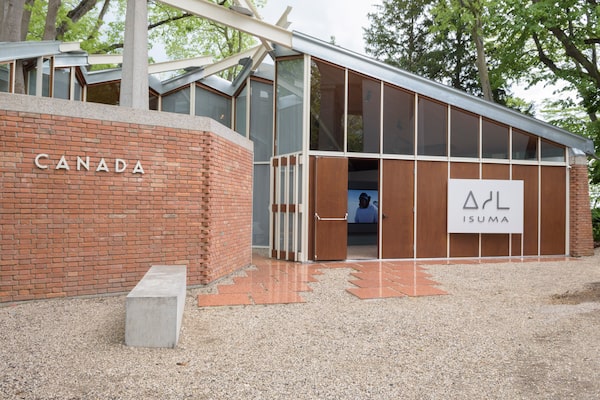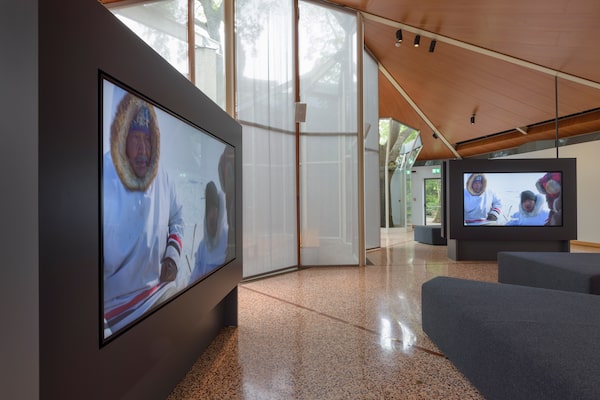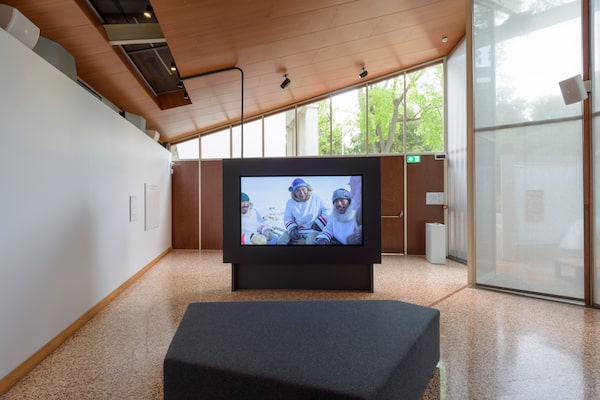
Canada Pavilion at the 58th Venice Biennale Arte.Francesco Barasciutti/National Gallery of Canada and Isuma Distribution International
The preview of the 58th Venice Biennale Arte on Wednesday was stuffed with incongruous sights from the puzzling fog effects completely eclipsing the entrance of the main exhibition hall to the arrival of the Indigenous Sami delegation from northern Finland, its members all dressed in brightly coloured traditional costume. And there, in the midst of the Biennale’s green giardini, was the Canadian filmmaker Zacharias Kunuk, sitting on the edge of an ice floe off Baffin Island, wearing his Order of Canada pin on a Toyota ball cap.
Kunuk was visiting the Canada Pavilion via satellite, beaming in from 5,000 kilometres away to treat the elite of the contemporary art world to a discussion about mineral extraction in the North Baffin region. Joined by four Inuit hunters, he and the men were supposed to be seal hunting, a sight that might have stopped the Eurocentric culturati in their well-heeled tracks. But the ice is already open and the snow is slushy: It’s too warm to hunt, so a long discussion of the environmental impact of the Mary River Mine ensued – in Inuktitut with some gentle simultaneous translation in English.
“We know the area we used to get caribou,” one elder said. “But there is no more caribou in that area since the Mary River project.” Another explained the frustration of trying to get help from the Greenpeace environmental group.
The irony of this conversation in the midst of the Biennale crowd’s intense urbanity seemed largely lost on the voracious art seekers wandering through the Canadian Pavilion – at least this one had a shorter line than the British Pavilion next door. What had successfully grabbed their attention earlier in the day was another facet of the programming offered by Isuma, the Inuit film and video collective led by Kunuk that is representing Canada at the 2019 Biennale.
Opinion: Canada’s entry to the Venice Biennale shows a country of impostors

Filmmaker Zacharias Kunuk visited the Canada Pavilion through satellite from Baffin Island.Francesco Barasciutti/National Gallery of Canada and Isuma Distribution International
The centrepiece of Isuma’s participation in Venice is One Day in the Life of Noah Piugattuk, a new 112-minute feature film by Kunuk and his Montreal producing and writing partner Norman Cohn. It is based on a real incident in 1961 when the Canadian government forced the last Inuit family that was still living a semi-nomadic existence into the settlement at Igloolik. Two hours is not one day, but the film has a hypnotic real-time effect and the central confrontation between Noah, played by Apayata Kotierk, and Boss, played by Kim Bodnia, is an extended sequence of repetition and misunderstanding. Indeed, Noah complains bitterly to the translator that this white man keeps asking the same questions as Boss prods the Inuit elder to accept a wooden house and family allowance in exchange for leaving the land.
Asinnajaq, a Montreal Inuit artist and one of five curators who orchestrated Isuma’s appearance at the Biennale, explained that the group had debated how to represent the collective’s work in Venice. There had been discussions of using set pieces and props from previous films – Kunuk is the creator of such celebrated films as Atanarjuat: The Fast Runner and Maliglutit – to find an approach that might have seemed more fitting for a visual art exhibition than a feature-length narrative.
“But the best fit here is to show your best work,” she said, as the day’s continuous screenings of One Day played in the background. She added that Isuma’s television work has been shown twice before at documenta, the contemporary art showcase in Kassel, Germany, and that the curators were prepared for the short attention spans of Biennale crowds. “We said nobody is going to sit for two hours but today people already have. … The goal is to open it to the possibility of the one-minute walkthrough or the two-minute sitdown; you will still get something out of it.”
As the Sami delegation arrived midway through the morning’s first screening and stuck around to say hello, Asinnajaq was particularly pleased to have another Indigenous group on the ground in the giardini.
“It’s nice not being the only ones here in Venice.”

Attendees were attracted to another facet of the programming offered by Isuma, the Inuit film and video collective led by Kunuk.Francesco Barasciutti/National Gallery of Canada and Isuma Distribution International
 Kate Taylor
Kate Taylor